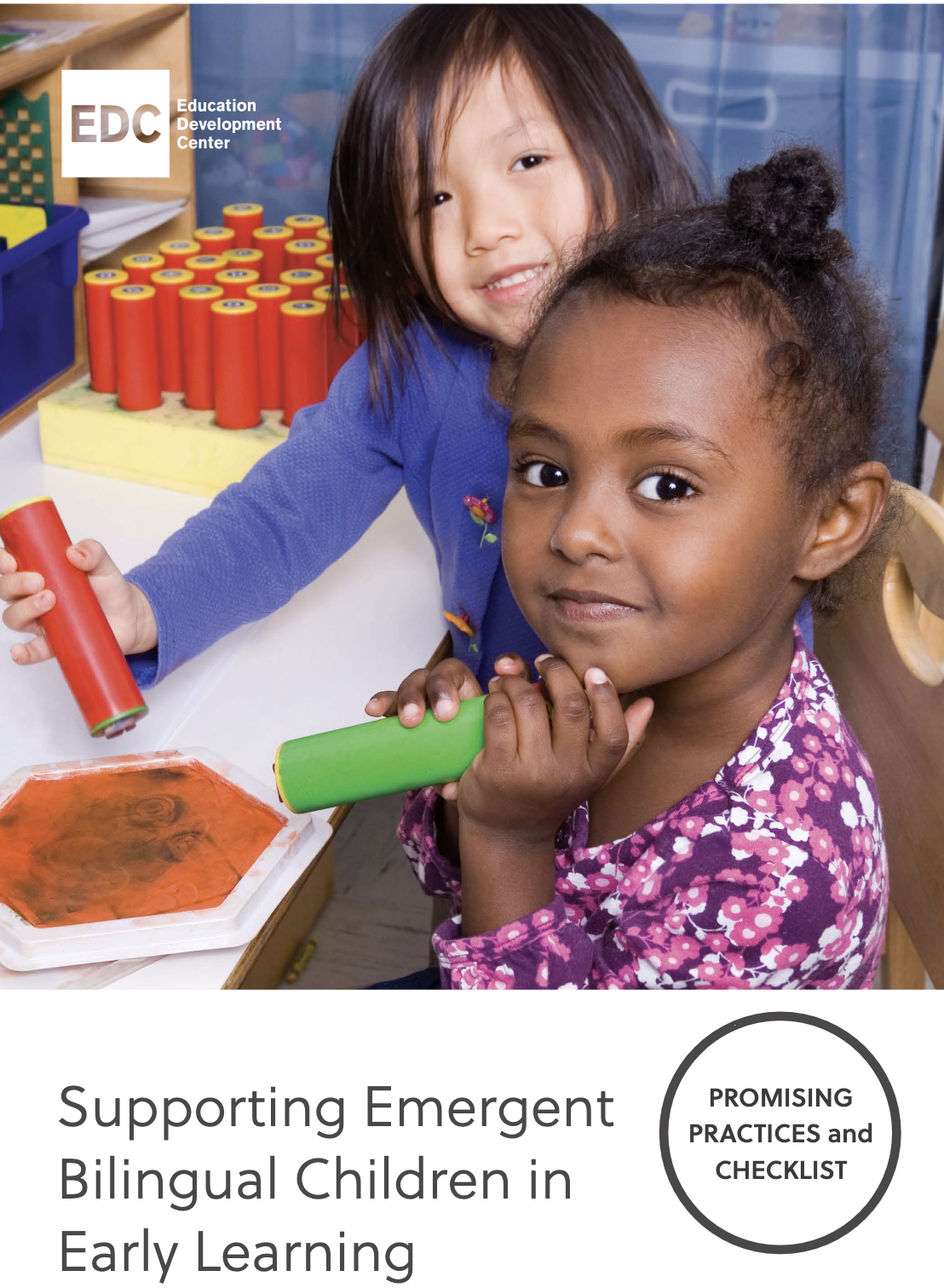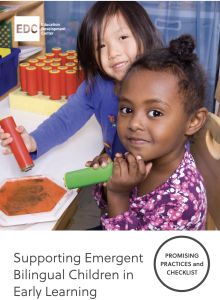Dual Language Learners: Resources for Educators and Caregivers [web resource]
 These resources from the Head Start Early Childhood Learning & Knowledge Center offer information and guidance on the needs of children who are acquiring two or more languages at the same time or are learning a second language while developing their first. Read more ›
These resources from the Head Start Early Childhood Learning & Knowledge Center offer information and guidance on the needs of children who are acquiring two or more languages at the same time or are learning a second language while developing their first. Read more ›


 Supporting Emergent Bilingual Children in Early Learning from Education Development Center (EDC) draws on current research into how children learn, giving educators promising practices for supporting the diverse needs of young learners.
Supporting Emergent Bilingual Children in Early Learning from Education Development Center (EDC) draws on current research into how children learn, giving educators promising practices for supporting the diverse needs of young learners. 
 Executive function skills help people stay focused, and manage the flow of information. Day to day, these skills allow a person to pay attention, plan ahead, remember details, and juggle multiple tasks. They also help control their behavior and emotions, delay immediate rewards for future benefits, and continue forward when faced with challenges.
Executive function skills help people stay focused, and manage the flow of information. Day to day, these skills allow a person to pay attention, plan ahead, remember details, and juggle multiple tasks. They also help control their behavior and emotions, delay immediate rewards for future benefits, and continue forward when faced with challenges. 
 When you hear a sound, how do you respond? You might choose to ignore it or investigate its source. This process of using our senses to interpret a situation and respond in a purposeful way is called sensory integration. When these systems don’t synthesize, whether due to a diagnosis like autism or ADHD or to a skills deficit, it can lead to a whole host of learning and behavioral challenges. Studies have found that 1 in every 6 children has sensory processing issues that make it more difficult for them to thrive in school.
When you hear a sound, how do you respond? You might choose to ignore it or investigate its source. This process of using our senses to interpret a situation and respond in a purposeful way is called sensory integration. When these systems don’t synthesize, whether due to a diagnosis like autism or ADHD or to a skills deficit, it can lead to a whole host of learning and behavioral challenges. Studies have found that 1 in every 6 children has sensory processing issues that make it more difficult for them to thrive in school. 
 ADHD is usually diagnosed in children; however, it often persists across one’s lifespan. Learn more about ADHD symptoms at different ages.
ADHD is usually diagnosed in children; however, it often persists across one’s lifespan. Learn more about ADHD symptoms at different ages. 
 It can be tough for any parent to get the special education services their kids need, but it’s especially tricky for Black and Hispanic parents.
It can be tough for any parent to get the special education services their kids need, but it’s especially tricky for Black and Hispanic parents. 
 Educational labeling was first introduced as a way of meeting students’ needs. For instance, a child who was labeled as “gifted” might move up in the curriculum, while a child with dyslexia might need to slow down or even repeat whole lessons or grades.
Educational labeling was first introduced as a way of meeting students’ needs. For instance, a child who was labeled as “gifted” might move up in the curriculum, while a child with dyslexia might need to slow down or even repeat whole lessons or grades. 
 When provided with the foundation of a safe environment, trusted mentors and opportunities to engage, all young people can be empowered to develop the skills they need to become self-advocates and elevate their voices.
When provided with the foundation of a safe environment, trusted mentors and opportunities to engage, all young people can be empowered to develop the skills they need to become self-advocates and elevate their voices. 
 Social-emotional learning is about cultivating a deeper care for the self in the present moment. That is something we all can do, and that is something that we should all do.
Social-emotional learning is about cultivating a deeper care for the self in the present moment. That is something we all can do, and that is something that we should all do.
 Children vary in their development of speech and language skills. However, they follow a natural progression or timetable for mastering the skills of language. A checklist of milestones for the normal development of speech and language skills in children from birth to 6 years of age is included below.
Children vary in their development of speech and language skills. However, they follow a natural progression or timetable for mastering the skills of language. A checklist of milestones for the normal development of speech and language skills in children from birth to 6 years of age is included below. 

